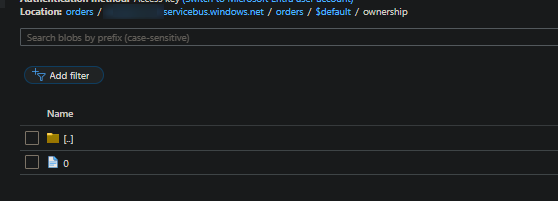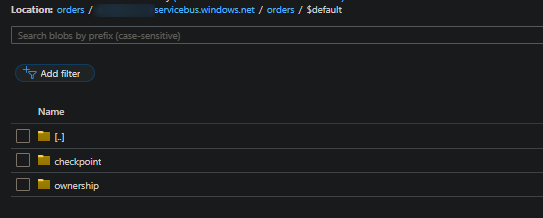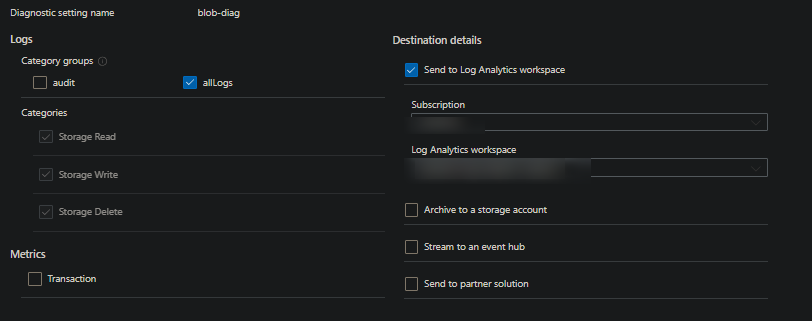Checkpoint strategies with Dapr, KEDA, Azure EventHub and Container Apps
This post will cover using Dapr and KEDA’s Azure EventHub scaler with Container Apps and how the ‘checkpoint strategy’ can affect this
Overview
You can use KEDA’s Azure EventHub scaler to scale based off of criteria set in your scalers metadata for Event Hub - and you can use Dapr enabled with your application to be able to send these messages to trigger this criteria. All of which can be done on Container Apps. But to make this properly work, you need to set the proper checkpointStrategy with KEDA.
As described here in “Checkpointing”, Checkpointing is a process by which readers mark or commit their position within a partition event sequence. Essentially, this helps set a location for clients to resume from - as an example, to prevent rereading from parts of the stream that may have already been read if there was an application restart.
Checkpoints require Azure Blob Storage to store a file - this files directory structure may be different depending on the client that created it, which is where checkpoint strategies come into play. Given that there are a lot of moving parts here, it can be broken down like this:
- Application (in this case, with Dapr’s Azure EventHub
pubsubcomponent) - creates the checkpoint - Azure Blob Storage - The checkpoint is stored here as a file. Directory structure may change depending on the client
- KEDA (with Azure EventHub scaler) - Needs to read from Azure Blob Storage for the checkpoint path for scaling criteria
- Azure EventHub - Ingests messages from the application/client and is used by KEDA for other scale criteria
This post won’t go into setting up a client or application with Dapr for Azure Event Hub, but you can essentially follow Pub/sub brokers - Azure Event Hubs - Dapr and the Getting started with Dapr on Container Apps
NOTE: In terms of troubleshooting, you can install Dapr locally and as long as Kubernetes is enabled in Docker Desktop (or whichever type of local Kubernetes you have), you can also install KEDA into your local cluster with Helm. You can effectively set up a local example of scaing with Dapr, KEDA and Azure Event Hub on Kubernetes
- This can potentially make troubleshooting certain issues easier prior to deploying or testing on Container Apps
Application - Checkpoint creation
This blog is about using Dapr with Azure Event Hub and a pubsub component. This is agnostic of the fact the Dapr SDK is used, or, by calling the daprd sidecar over HTTP directly, as either scenario will create the same path across different languages.
When publishing a message to eventhub and with a brand new blob container in your Azure Storage account, you’ll notice the following directory structure appear:

| - yourblob (this is the root)
| - youreventhub.servicebus.windows.net
| - yourentitypath
| - consumergroup ($default is the eventhub default)
| - ownership
| - 0
Flattened out this will look like orders/youreventhub.servicebus.windows.net/orders/$default/ownership/0.
If you have not yet published a message to eventhub, then the checkpoint directory will not yet be created. This may show as a BlobNotFound error from storage, through KEDA logs, until it’s created. This specific situation is not an issue if the checkpoint strategy has been correctly configured and messages have not yet been sent to EventHub. This is important for later on regarding troubleshooting.
After you create your first message, the structure will change to have the following added, which is the checkpoint directory under your consumer group:

| - yourblob (this is the root)
| - youreventhub.servicebus.windows.net
| - yourentitypath
| - consumergroup ($default is the eventhub default)
| - ownership
| - 0
| - checkpoint
| - 0
Flattened out and looking at just the checkpoint, this will look like orders/youreventhub.servicebus.windows.net/orders/$default/checkpoint/0.
The “checkpoint” that has been referenced in this post so far is now created. This is incredibly important to be aware of for strategies and potentially for troubleshooting purposes.
NOTE:
youreventhub.servicebus.windows.netcorresponds to the eventhub namespace in this particular example of how a checkpoint path is created
KEDA - Utilizing checkpoint strategies
Now we have a client that can create a checkpoint in blob storage. If you want to use KEDA to scale with event hub, you need to set the correct checkpointStrategy in your scaler metadata. KEDA’s information on strategies for this scaler is found here.
An example of this property:
triggers:
- type: azure-eventhub
metadata:
blobContainer: "orders"
unprocessedEventThreshold: "1"
# This is important
checkpointStrategy: "blobMetaData"
.... other properties
The reason this is so important is because certain strategies use certain blob paths. if the strategy used uses a different blob path lookup than what your current structure is, you’re going see a 404 returned from Azure Storage through KEDA that it can’t find the blob location. Thus, scaling through KEDA won’t happen (although it won’t technically cause any downtime from an availability/performance scenario on Container Apps).
How the scaler determines checkpoints can be found in KEDA’s azure_eventhub_checkpoint.go file here. This is generally the following logic and how it makes a call to your blob for checkpoint lookups:
azureFunction:
azure-webjobs-eventhub/[eventhub_namespace]/[eventhub_name]/[consumer_group]/[checkpointid]- Example:
azure-webjobs-eventhub/youreventhub.servicebus.windows.net/orders/$Default/0 - Note, this strategy implicitly expects to have your blob container be named
azure-webjobs-eventhub
- Example:
dapr
[blobcontainer]/dapr-[eventhub_name]-[consumer_group]-[checkpointid]- Example:
orders/dapr-myeventhub-$default-0
goSdk:
[blobcontainer]/[checkpointid]- Example:
orders/0
blobMetadata:
[blobcontainer]/[eventhub_namespace]/[eventhub_name]/[consumer_group]/checkpoint/[checkpointid]- Example:
yourblobcontainer/youreventhub.servicebus.windows.net/orders/$default/checkpoint/0
Non-matching:
[blob_container]/[consumer_group]/[checkpoint_id]- example:
orders/$default/0
Case sensitivity matters. If you input a value to checkpointStrategy that is different from the casing expected, it’ll default to the default checkpoint strategy.
If you don’t already know specifics on the directory structure created for a strategy on the client side - navigate to your storage account as seen earlier and compare it with the available strategies paths here.
In this blog’s case, with using Dapr and the pubsub component for Eventhub - using the blobMetadata strategy matches our need to scale with KEDA.
Troubleshooting
Container Apps
On Container Apps, you can use the ContainerAppSystemLogs_CL table if using Log Analytics, or ContainerAppSystemLogs, if using Azure Monitor, to review KEDA scaling errors. Generally, what would be seen in a normal instance of the KEDA operator pod would surface here.
If we have a mismatch in checkpoint strategies versus the structure in storage, a message like this would show below (assuming the blob container actually exists):
error": "-> github.com/Azure/azure-storage-blob-go/azblob.newStorageError, /workspace/vendor/github.com/Azure/azure-storage-blob-go/azblob/zc_storage_error.go:42\n===== RESPONSE ERROR (ServiceCode=BlobNotFound) =====\nDescription=The specified blob does not exist.\nRequestId:00000000-0000-0000-0000-000000000000\nTime:2024-11-05T15:02:36.3397719Z, Details: \n Code: BlobNotFound\n GET https://mystorage.blob.core.windows.net/orders/$Default/0?timeout=61\n Authorization: REDACTED\n User-Agent: [Azure-Storage/0.15 (go1.21.9; linux)]
IMPORTANT: Currently with KEDA 2.15.1, this error will not be correctly shown due to the bug in this GitHub issue - [Keda operator fails with “unable to get unprocessedEventCount for metrics: unable to get checkpoint from storage: %!w(
This in itself is not related to Container Apps, but rather purely KEDA. If setting up and troubleshooting this integration for the first time and this error is seen on 2.15.1, it may be best to install a local version of KEDA with Kubernetes and Dapr and use a different version, like 2.14.1 or 2.16.
Azure Storage
Instead of just only relying on KEDA logs to figure out what blob path is being used for strategies, you can see what path is requested with Log Analytics on your Storage Account.
To see this, you need to first set Diagnostic Settings up. For “blob”, add a category for allLogs. After 5 - 10 minutes, storage logs should start populating in Log Analytics.
- Go to the Diagnostic Settings on your storage account
-
Select “blob”:

-
Add a category setting for
allLogsand send it to a Log Analytics workspace.
-
You can then query the
StorageBlobLogstable to see what kind of requests are being made
UserAgentHeadercan be used to tell who is making the request. In this case,azsdk-gois from KEDA. Ones starting withdaprare fromdaprd.
Other considerations
Users who try to alter the checkpoint path (eg. going in and deleting directories) may cause application and/or KEDA scaler failures, especially if the path is not able to be recreated.
Breaking changes from a client perspective that may create a different path than what is currently set for KEDA’s checkpointStrategy could cause KEDA scaler failures as well.


